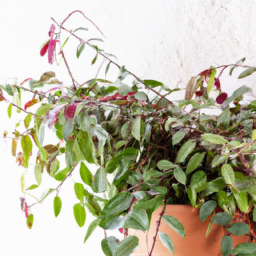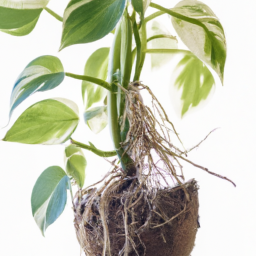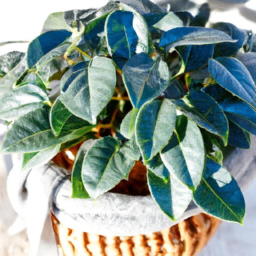
As the winter season approaches, many plant lovers may be wondering how to care for their indoor plants during the colder months. Indoor Plants During Winter require special attention and care to ensure they thrive in the indoor environment. With the drop in temperature and decrease in natural light, it’s important to make adjustments to your plant care routine to keep your green friends happy and healthy throughout the winter season. In this blog post, we’ll explore some tips and tricks for caring for indoor plants during winter, so you can keep your plant babies thriving all season long.
Benefits of Keeping Indoor Plants During Winter
Improved Air Quality
During the winter months, when we tend to keep our windows and doors closed to keep the cold air out, indoor air quality can suffer. Indoor plants act as natural air purifiers, absorbing toxins and releasing oxygen into the air. This can help improve the air quality in your home, making it a healthier environment for you and your family. Some plants, such as spider plants and peace lilies, are particularly effective at removing pollutants from the air.
In addition to absorbing toxins, indoor plants also release moisture into the air through a process called transpiration. This can help combat the dry air that is common during the winter months, which can lead to dry skin, irritated sinuses, and other respiratory issues. By keeping indoor plants in your home during the winter, you can help maintain a comfortable level of humidity in your indoor environment.
Not only do indoor plants improve air quality and humidity levels, but they can also help reduce stress and improve mental well-being. Studies have shown that being around plants can help lower blood pressure, reduce anxiety, and improve mood. So, by keeping indoor plants in your home during the winter, you can create a more relaxing and peaceful environment for yourself and your loved ones.
Boosted Immune System
During the winter months, when cold and flu season is in full swing, it’s important to take steps to boost your immune system. Indoor plants can actually help with this. Some plants, such as aloe vera and eucalyptus, have natural antibacterial and antiviral properties that can help purify the air and prevent the spread of germs. By keeping these plants in your home during the winter, you can help reduce your risk of getting sick.
In addition to their antibacterial and antiviral properties, indoor plants can also help boost your immune system by reducing stress. As mentioned earlier, being around plants has been shown to lower blood pressure, reduce anxiety, and improve mood. All of these factors can help strengthen your immune system and make you less susceptible to illness during the winter months.
Furthermore, caring for indoor plants can also provide a sense of purpose and accomplishment, which can help improve mental well-being and overall health. By tending to your plants and watching them thrive, you can feel a sense of pride and satisfaction, which can have a positive impact on your immune system and overall well-being.
Enhanced Home Decor
In addition to the health benefits of keeping indoor plants during the winter, they can also enhance the aesthetic appeal of your home. Plants add a touch of nature and color to indoor spaces, making them feel more inviting and cozy. Whether you prefer large, statement plants or small, delicate succulents, there are endless options to choose from to suit your personal style and home decor.
Indoor plants can also help create a sense of tranquility and relaxation in your home, which is especially important during the winter months when we tend to spend more time indoors. By strategically placing plants in different rooms of your home, you can create a harmonious and peaceful atmosphere that promotes well-being and comfort.
Furthermore, caring for indoor plants can be a rewarding and fulfilling hobby that can bring joy and satisfaction during the long winter months. Watching your plants grow and thrive can be a source of happiness and pride, and can help pass the time during those cold and dreary days. So, not only do indoor plants enhance the beauty of your home, but they can also bring a sense of joy and fulfillment to your life during the winter season.

Best Indoor Plants to Thrive in Winter Conditions
Choosing the Right Indoor Plants
When it comes to selecting indoor plants that will thrive during the winter months, it’s important to consider a few key factors. First and foremost, you’ll want to choose plants that are well-suited to low light conditions. During the winter, the days are shorter and there is less natural sunlight available, so it’s crucial to pick plants that can still thrive in these circumstances. Some great options for low light conditions include snake plants, pothos, and peace lilies.
In addition to considering light requirements, you’ll also want to think about the temperature and humidity levels in your home. Winter can bring dry air, which can be tough on some plants. To combat this, you may want to consider plants that thrive in humid environments, such as ferns or orchids. These plants will do well in the slightly higher humidity levels that are often present in homes during the winter months.
Lastly, consider the size of your indoor space when choosing plants. If you have limited space, you may want to opt for smaller plants that can be easily placed on shelves or countertops. On the other hand, if you have a larger space to work with, you may want to consider larger plants that can make a statement in your home.
Caring for Your Indoor Plants
Once you’ve selected the right indoor plants for winter conditions, it’s important to ensure that you are properly caring for them to help them thrive. One of the most important things to remember is to water your plants appropriately. During the winter, plants may not need to be watered as frequently as they do during the warmer months. Be sure to check the soil moisture before watering to avoid overwatering, which can lead to root rot.
In addition to watering, it’s also important to monitor the humidity levels in your home. As mentioned earlier, winter can bring dry air, which can be tough on some plants. To increase humidity levels, you can mist your plants with water or place a humidifier nearby. You can also group plants together to create a microclimate that is more humid.
Finally, be sure to regularly dust your plants’ leaves to ensure that they are able to absorb as much light as possible. Dust can accumulate on leaves over time, which can block sunlight and hinder photosynthesis. Simply wipe the leaves gently with a damp cloth to keep them clean and healthy.
Dealing with Common Winter Plant Issues
Even with the best care, indoor plants can sometimes run into issues during the winter months. One common problem is pests, such as spider mites or aphids, which can thrive in the dry indoor air. To combat pests, you can try spraying your plants with a mixture of water and mild dish soap, or introduce natural predators such as ladybugs.
Another issue that can arise during winter is overwatering. With lower light levels and cooler temperatures, plants may not be using as much water as they do during the warmer months. Be sure to adjust your watering schedule accordingly to prevent root rot and other issues related to overwatering.
Lastly, keep an eye out for signs of stress in your plants, such as yellowing leaves or wilting. These can be indicators that your plants are not getting the right amount of light, water, or nutrients. By paying attention to your plants and adjusting your care routine as needed, you can help them thrive throughout the winter months.

Tips for Caring for Indoor Plants During the Winter Months
Understanding the Needs of Indoor Plants During Winter
During the winter months, indoor plants require special care to thrive in the colder and drier conditions. One of the most important factors to consider is the amount of light your plants are receiving. With shorter days and less sunlight during the winter, it is essential to place your plants in a location where they can still receive adequate light. Consider moving them closer to windows or investing in grow lights to supplement their light intake.
In addition to light, indoor plants may also require adjustments to their watering schedule during the winter. The dry air in many homes during the winter can cause plants to lose moisture more quickly, so it is important to monitor the soil moisture levels regularly. Be sure to water your plants when the top inch of soil is dry to the touch, but be careful not to overwater as this can lead to root rot.
Another important aspect of caring for indoor plants during the winter is maintaining the right humidity levels. Indoor heating systems can cause the air in your home to become dry, which can be detrimental to your plants. To increase humidity levels, consider placing a humidifier near your plants or grouping them together to create a microclimate with higher humidity.
Protecting Indoor Plants from Drafts and Temperature Fluctuations
During the winter months, it is crucial to protect your indoor plants from drafts and temperature fluctuations that can occur near windows and doors. Cold drafts can be harmful to many houseplants, so be sure to move them away from drafty areas. You can also use draft stoppers or insulating materials to prevent cold air from reaching your plants.
In addition to drafts, temperature fluctuations can also be a concern for indoor plants during the winter. Avoid placing your plants near heat sources such as radiators or vents, as the sudden temperature changes can stress your plants. Instead, aim to keep your plants in a location with consistent temperatures, ideally between 65-75 degrees Fahrenheit.
If you notice that your plants are showing signs of stress, such as yellowing leaves or drooping stems, it may be a sign that they are not receiving the proper care during the winter months. Take the time to assess the conditions in your home and make any necessary adjustments to ensure that your indoor plants remain healthy and happy throughout the winter.
Pruning and Fertilizing Indoor Plants in Winter
While indoor plants may grow more slowly during the winter months, it is still important to continue caring for them through regular pruning and fertilizing. Pruning can help promote new growth and maintain the shape of your plants, so be sure to trim any dead or yellowing leaves as needed. Additionally, removing any leggy growth can help encourage your plants to grow bushier and healthier.
In terms of fertilizing, indoor plants typically require less fertilizer during the winter when they are not actively growing. However, it is still important to provide them with some nutrients to support their overall health. Consider using a diluted fertilizer every 4-6 weeks to give your plants a boost during the winter months.
By following these tips for caring for indoor plants during the winter months, you can help ensure that your plants stay healthy and vibrant throughout the colder season. With a little extra attention and care, your indoor plants can thrive even when the weather outside is less than ideal.
In a Nutshell
With the arrival of winter, it’s important to consider how the colder temperatures and reduced sunlight can affect our indoor plants. While some plants may thrive in the cozy indoor environment, others may struggle to adapt to the changing conditions. One key factor to keep in mind is the amount of sunlight your plants are receiving. With shorter days and less intense sunlight, it’s important to move plants closer to windows or invest in grow lights to help them thrive during the winter months.
Another important consideration during the winter is the humidity levels in your home. Indoor heating can dry out the air, which can be detrimental to many houseplants. To combat this, consider placing a humidifier near your plants or misting them regularly to help maintain the proper moisture levels. Additionally, be mindful of overwatering your plants during the winter, as they may not be growing as quickly and therefore require less frequent watering. By being attentive to these factors, you can ensure that your indoor plants stay healthy and vibrant throughout the winter season.
Curious Minds Asked, We Responded. Frequently Asked Questions:
Q1: Can indoor plants survive during winter?
A1: Yes, indoor plants can survive during winter with proper care and attention. It’s important to adjust watering schedules, provide adequate light, and maintain appropriate humidity levels to help your plants thrive during the colder months.
Q2: How often should I water my indoor plants in winter?
A2: During winter, indoor plants generally require less frequent watering due to lower light levels and cooler temperatures. It’s best to check the soil moisture level before watering and adjust your watering schedule accordingly. Overwatering can be harmful to plants, so it’s important to let the soil dry out between waterings.
Q3: Do indoor plants need special lighting during winter?
A3: Indoor plants may require additional lighting during winter, especially if they are not receiving enough natural sunlight. Consider supplementing with grow lights to provide the necessary light for your plants to thrive. Positioning plants near windows can also help maximize natural light exposure.
Q4: How can I increase humidity for my indoor plants during winter?
A4: To increase humidity for indoor plants during winter, you can place a humidifier near your plants, group plants together to create a microclimate, mist plants with water, or place a tray of water near the plants to evaporate and increase humidity levels. Proper humidity levels are essential for the health of indoor plants, especially during the dry winter months.
Q5: Are there any specific indoor plants that do well during winter?
A5: Some indoor plants are better suited for the lower light and cooler temperatures of winter. Plants like pothos, snake plants, peace lilies, and spider plants are known to be more resilient and adaptable to winter conditions. It’s important to choose plants that are well-suited for the environment in which they will be placed to ensure their success during winter.

James Wong is a renowned ethnobotanist, plant scientist, and local television presenter. With a passion for demystifying plant science, he is known for translating complex botanical concepts into practical advice for everyday plant enthusiasts. James’s expertise spans from traditional gardening to cutting-edge plant technologies, making his insights accessible and informative.


